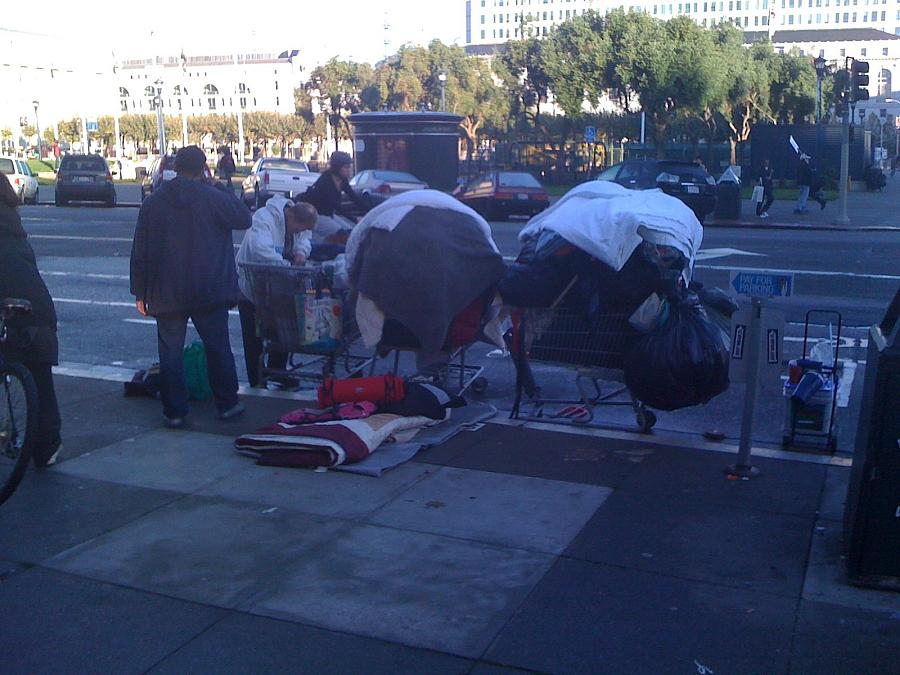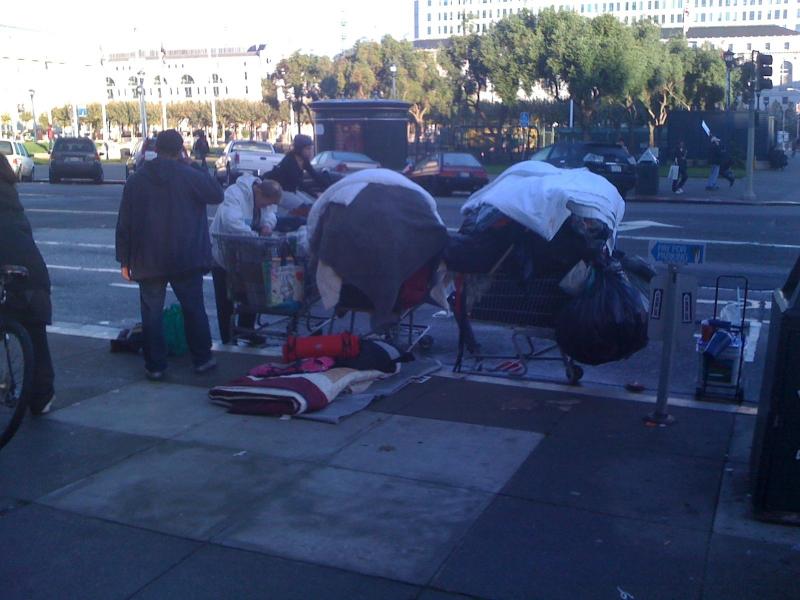Meet San Francisco's 477 Most Expensive "HUMS" (High Utilizers of Medical Services)

 The most costly user of publicly financed emergency health services in San Francisco – a "frequent flyer" in emergency room parlance – is 49, Caucasian, schizophrenic, and addicted. He has been listed in at least two concurrent city systems as homeless (either continuously or episodically) for 16.6 years. He's a frequent caller of ambulances (more than four times a month), a frequent user of detox and sobering center services, and a high utilizer of mental health services (including psych emergency). He is very, very ill. Based on three years of mortality data for very similar people, his chances of dying this year alone range from one in 10 to one in 20.
The most costly user of publicly financed emergency health services in San Francisco – a "frequent flyer" in emergency room parlance – is 49, Caucasian, schizophrenic, and addicted. He has been listed in at least two concurrent city systems as homeless (either continuously or episodically) for 16.6 years. He's a frequent caller of ambulances (more than four times a month), a frequent user of detox and sobering center services, and a high utilizer of mental health services (including psych emergency). He is very, very ill. Based on three years of mortality data for very similar people, his chances of dying this year alone range from one in 10 to one in 20.
It took tremendous effort, but he's got a legal conservator, and he's been in the Department of Public Health's intensive case management program.
Even so, last year he used an estimated $155,453 worth of emergency and urgent services alone (not counting other medical costs).
In each of the three years that anyone's been keeping track, he's ranked in the city and county's list of highest utilizers of multiple services.
This year, for the first time, he's number one.
So how do we know he's number one? Who managed to rank these extremely transient patients? Such a feat would seem nearly impossible in a fragmented urban safety-net system.
Four years ago, a tiny group of committed people set out to figure out how to track, and help, those people who are failing (and being failed by) our public health safety net systems. The brilliance of their approach was to take isolated silos of data and merge them together. No employee had to change how he worked or modify a database. All they had to do was dump their data to a central digital safety-net warehouse.
Why was this even necessary, you might be asking, when the same local jurisdiction is probably paying for all of these services? Doesn't everyone know who's getting what?
Unfortunately, no. In our rush to buy and develop electronic platforms, every agency has its own database -- an incompatibility problem that becomes more complex the more people served. The data system for ambulances doesn't talk to the data system for shelters and housing, which doesn't talk to the data system for elder services, which doesn't talk to the mental health system, or the substance abuse system or the medical system or the jail system or You get the picture.
But San Francisco figured out how to dump all these data systems once a night into one virtual data "bucket," unduplicate the clients into an individual service record, and then take a look.
That's where the second brilliant step occurred. When you're looking at this type of high volume data, the typical approach would be to look for outliers by category. For example, the highest cost user of medical services might be someone who was hospitalized for nine months. But Maria X. Martinez, who headed this group, realized that systems already existed to address single-category high utilizers.
Instead, Martinez decided to do something completely novel and look for high utilizers across multiple systems (what the group calls HUMS). To find them, she created ranked scores for separate categories of higher-cost, intensive services. Each type of service got its own score of high utilizer. Otherwise, if all the services were lumped together first and then ranked by cost or intensity, a service that is relatively cheap, like detox or a shelter bed-day, would get completely erased by higher-cost items like an ambulance run. Once the scores were created, each person got a ranking for each category of service, based on the intensity of his use of emergency or urgent services.
What Martinez found is a whole population of people suffering, dying, and using safety net services in extraordinarily inefficient and high-cost ways.
And they are almost all homeless.
The HUMS database, as of February 2, 2011, contains 227,223 people, with data going back as far as 1992.
Of those 227,223 people, 18 percent (50,266 ) have at some point been listed as homeless by two or more different systems. Of the people who received services last year, 6 percent (16,494) were listed as homeless by two or more data systems during 2009-2010.
That number, 16,494, is markedly higher than the current official estimates of the number of homeless in San Francisco. Homelessness is a state of constant churn into and out of marginal housing options. This higher number may represent a more accurate estimate of the numbers of people dealing with transitory homelessness in a year.
High utilizers of ambulance services are defined as having used an ambulance more than four times a month. Collectively, this subgroup racked up 3,093 transports, 74 percent of them for sobering center clients.
In 2009-2010, 477 people were ranked as High Utilizers of Multiple Systems, and they used $20 million worth of urgent/emergency services -- an average of $42,067 each.
The average age was 47.8, 75 percent were male, 92 percent spoke English, 49 percent were Caucasian, 29 percent were African American, and 12 percent were Latino.
Thirty nine percent were high utilizers of ambulance services, 77 percent had used urgent/emergency substance abuse services, and 75 percent had used urgent/emergency mental health services.
Twenty seven percent had a diagnosis of schizophrenia, and 15 percent had had legal conservators at some point. Sixteen percent were HIV-infected, and 42 percent had hepatitis C.
The top 100 used $8.1 million worth of urgent/emergency services alone in that year.
Clearly, the situation can't go on. But what are the options?
You can imagine the challenges of trying to help people like this. Imagine you're a case manager and you've been given the task of managing last year's top high ($155,453 worth of services last year) and, by doing so, addressing his overwhelming menu of psycho-social, behavioral, mental health, substance abuse, and medical problems.
But "Murray" doesn't have a phone, or an address, or a calendar, or even a regular spot on a sidewalk. He cycles between intoxication and withdrawal and has to wake up two or three times a night to drink so his withdrawal shakes won't be so bad in the morning. He's so incoherent at baseline that it's hard to tell at any one time if he's hallucinating from his schizophrenia, suffering from the DTs (delirium tremens), showing symptoms of alcohol-induced dementia, just being belligerent, or has another concussion from his many episodes of severe head trauma. His conservator has no idea where to find him.
If he ever stays in a setting long enough to be sobered up (usually that requires a long hospital stay), he becomes pretty coherent, tries to get his conservatorship canceled, and leaves against medical advice to go get a drink. Like almost all HUMS patients, Murray has been assigned a primary care clinic. But he's never once kept an appointment, and no one really thinks he ever will, since he can't usually tell you what day it is.
If you're his case manager, it might be easy to conclude that you were set up to fail. But are you? And is the seeming impossibility of the situation a good enough reason to give up?
There is an old saying in medical training: "Don't ask the question if you don't want to know the answer." It's a saying that's used to encompass a lot of situations, for instance, whether you should check for asymptomatic heart disease in someone dying of terminal cancer. Once you know it's there, it's going to be hard to ignore.
Martinez and her group knew what they might find when they defined high utilizers of multiple systems, but went looking for it anyway. In a high-stakes political climate, that's an act of bravery, since once they had a result, they were going to be asked to deal with it, however difficult that may be. And because they designed a method for seeing what happens, they can't hide whether they're failing or succeeding, either.
Although some might say that San Francisco is uniquely plagued by homelessness, a similar group of HUMS-type people can probably be found in most urban areas. Has your area identified them yet? The big question is what we all, collectively, are going to do to address their suffering and premature death – and their inefficient and costly use of safety-net services.
Disclaimer: Identifiable patients mentioned in this post were not served by R. Jan Gurley in her capacity as a physician at the San Francisco Department of Public Health, nor were they encountered through her position there. The views and opinions expressed by R. Jan Gurley are her own and do not necessarily reflect the official policies of the City and County of San Francisco; nor does mention of the San Francisco Department of Public Health imply its endorsement.
Photo by R. Jan Gurley
